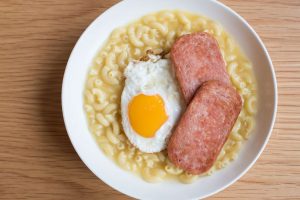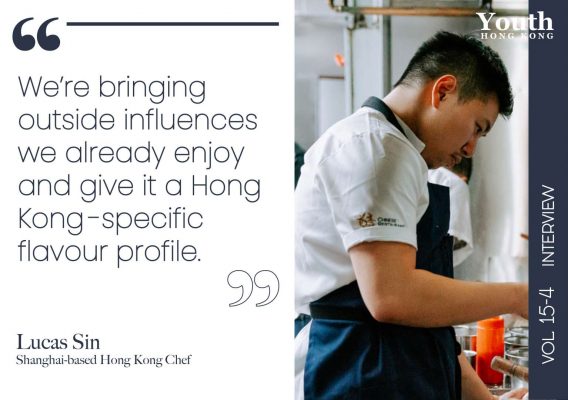//vol.15-4 Interview: Lucas Sin
Macaroni in the Soup
While exploring the importance of innovation, inclusiveness and open-mindedness in fusion foods, Lucas Sin, a young Hong Kong chef based in Shanghai, explains how he’s taking the homestyle Cha Chaan Teng culture to the world.

In the vibrant city of Hong Kong, Lucas Sin discovered more than a post-colonial metropolis where Eastern and Western cultures intertwine. For him, it was the lively ambience of the local Cha Chaan Teng, the Hong Kong-style diners resonating with chatter and laughter, the comforting, affordable and down-to-earth food, and the tantalising aromas wafting from sizzling wok-fried dishes, that captured his heart.
「It’s a profound sense of nostalgia and being at home. I constantly crave the simplest dishes found in Hong Kong, like the clear broth beef brisket. I haven’t been able to find the perfect rendition outside of Hong Kong, with the right cut of meat and the perfect broth,」 said Lucas.
Born and raised in Hong Kong, Lucas carried his love of Hong Kong cuisine to the United States during his college years, and his passion for sharing the rich Chinese food culture with a wider and younger group of diners has never waned.
Following his graduation from Yale University and subsequent move to New York in 2017, Lucas co-founded Chinese restaurant brands Junzi and Nice Day with his business partners. They set out to introduce fast-casual Chinese and American-Chinese cuisine to campuses and neighbourhoods in New Haven and New York. Drawing inspiration from fast-food models employed by food chains like Subway and Chipotle, Lucas pioneered a way to bring Chinese home cooking to a wider audience by allowing them to build their own meals and combinations in a bowl. Famous hearty dishes like Sichuan Mapo Tofu and Lion’s Head Meatballs are introduced to their signature rice bowls.

After a decade of cooking this type of Chinese food in the US, Lucas decided to embark on a new culinary adventure, shifting gears from New York to Shanghai. Here he began experimenting at various food events and pop-ups. Regularly shuttling between Shanghai and Hong Kong, Lucas dedicated himself to creating innovative recipes and introducing Cha Chaan Teng cuisine to a wider Chinese audience, highlighting how fusion foods can constantly and excitingly evolve. Lucas’s quest for exploring traditional Chinese cuisine and infusing it with elements from diverse cultures and techniques mirrors a significant trend in the food industry today.
Lucas believes in the value of cultural traditions while embracing the opportunity to reinterpret age-old recipes. Having immersed himself in diverse cultures in Hong Kong, New York, and Shanghai, he has gained a unique perspective on the food culture of his hometown and is excited to share the flavours and the warmth of connection associated with it with a broader range of diners.
One aspect of Cha Chaan Teng culture that captivates Lucas is its fusion nature, and for good reason. This sets it apart from the conventional concept of fusion food. As he explained, the old image of fusion food is probably European chefs who add lemongrass to French-style fish, because they went to Thailand. In these cases, the Asian part is always the secondary part and is why they cook. “They’re just adding some flavour from somewhere far away into a culture and a recipe that they already made.”
Conversely, the fusion nature of Cha Chaan Teng food, taking macaroni soup, for example, is different.
“One of the interesting things about Cha Chaan Teng is that the dishes were made by Hong Kong people, for Hong Kong people. It’s not made by Chinese people primarily to sell to other cultures. We’re bringing other outside influences into our Hong Kong kitchen so that we can change something from outside that we already enjoy and give it a Hong Kong-specific flavour profile,” Lucas said.
“Macaroni soup has become an almost unique type of delicious pasta that we eat every day with a unique texture.”
Although Lucas started a new food journey in Shanghai and now stays behind the curtain as a business partner for his food brands in the US, his culinary ventures abroad have given him a profound understanding of the fusion nature and inclusivity of Chinese cuisine, especially in the diasporic Chinese community.
While there is a common perception in the US that American-Chinese food is not real Chinese food, Lucas argued that cuisines coming from a different path of history doesn’t mean that they are not real. Historically, Lucas explained how Chinese food in the US has picked up many influences that are unique to American cultural and geopolitical reasons.

He gave examples of how American-Chinese restaurants, which were, and until nowadays, mainly owned by the Cantonese community, developed sweet and sour flavour profiles based on the romanticised image of Polynesia and Tiki culture brought by American soldiers returning from World War II. The famous dishes like Pu Pu platters and Crab Rangoons show the delightful marriage of Chinese cuisine and Polynesian tropical elements.
Lucas finds inspiration in this rich history of American-Chinese food culture, particularly in the inclusiveness of Hong Kong cuisine. During his time in Shanghai, Lucas made a similar and intriguing observation about the city’s emerging fusion trend. One of his favourite to-go places in Shanghai is bistros, which originally drew influence from French dining.
Currently splitting his time between Shanghai and Hong Kong, Lucas is captivated by this fusion idea in both cities, where traditional Chinese restaurants are being reimagined with a new youthful perspective.
Whether partnering with innovative restaurants in Shanghai or conversing with local fishermen at Hong Kong’s morning market, Lucas embraces the power of food to forge meaningful connections and bring people together — not just food for food’s sake, but how food’s adaptability celebrates culture, authenticity and taste. ■
Photos: William Luk, Graeme Kennedy, Lucas Sin


